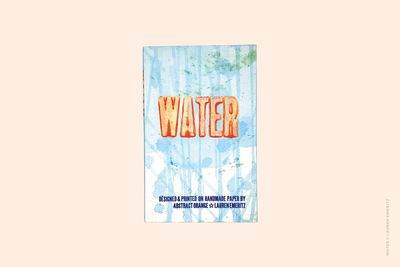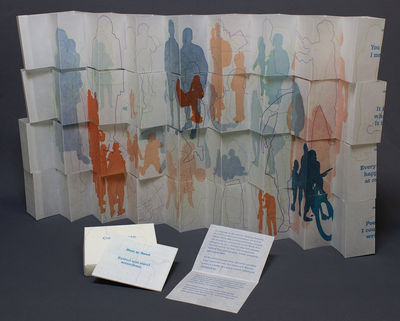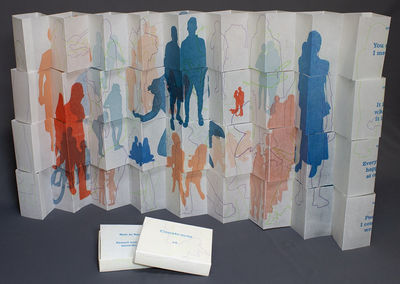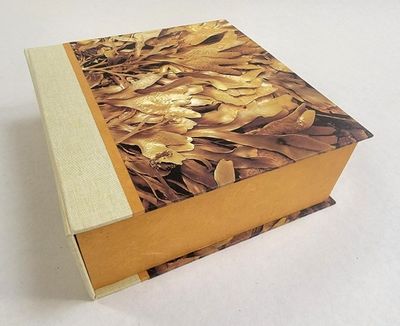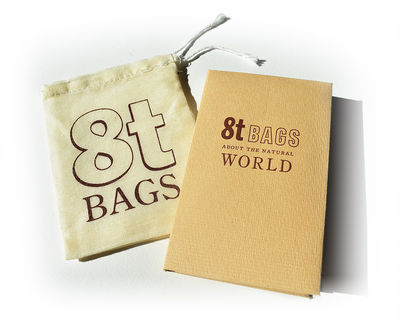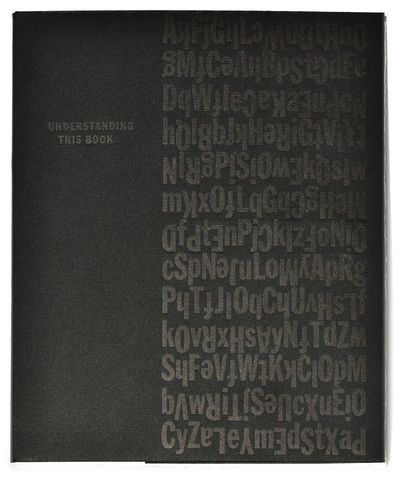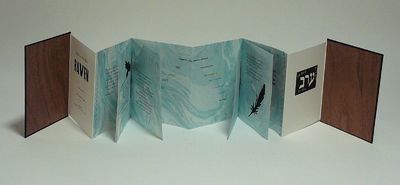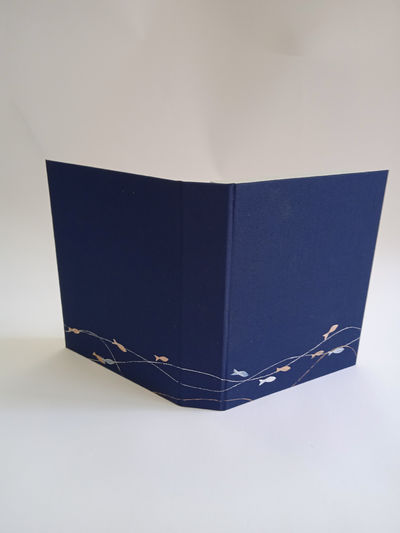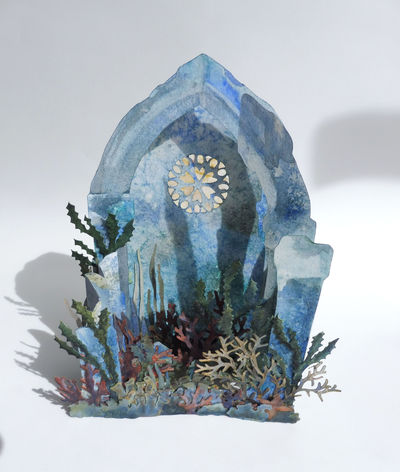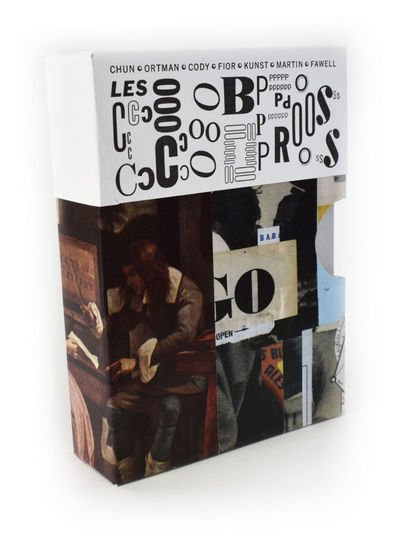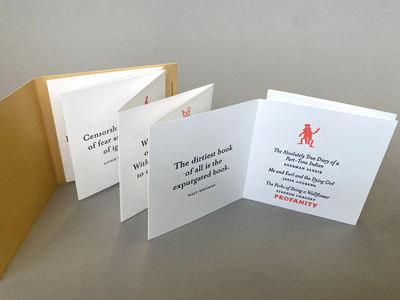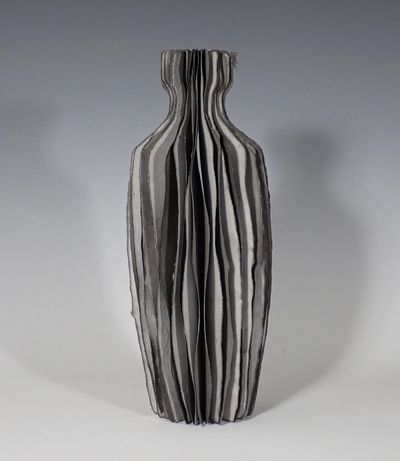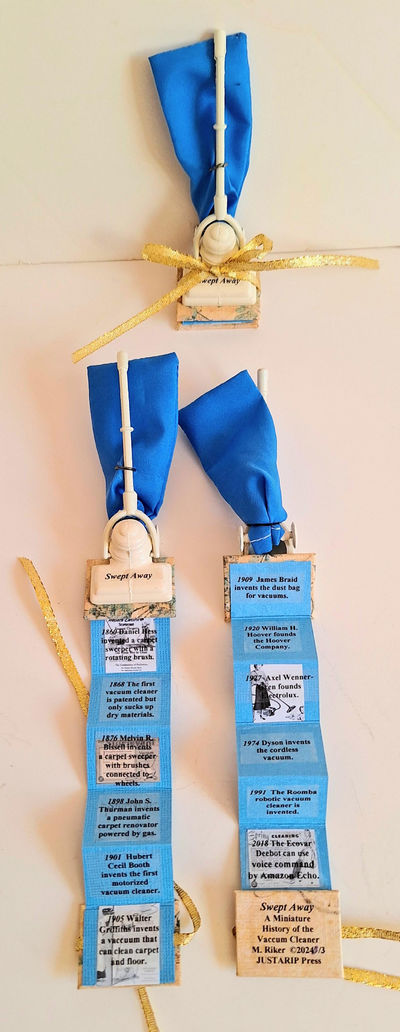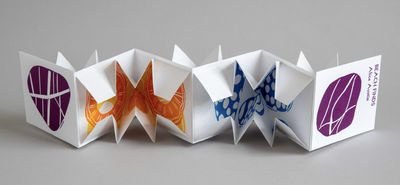
Aly, Islam.
Cairo, Egypt:, 2024.
Cairo, Egypt:: Islam Aly,, 2024.. Edition of 30 variants. 3 x 3 x 1" in hand carved camel bone covers. Materials: laser-cut handmade paper, linen thread, book board, hand carved camel bone covers. Coptic binding. Signed and numbered by the artist. Islam Aly: "In 'Perspectives', the inaugural volume of the Junctions Series, readers are invited to explore a visual journey through the cover pattern developing inside the book. Inspired by the intricacies of Coptic book covers, 'Perspectives' is weaving together elements of art, culture, and history to create a unique visual experience.� "The Junctions Series draws inspiration from the intricate beauty of Coptic book covers, known for their ornate designs and rich symbolism. Each book in this series serves as a connection between the past and present, blending traditional craftsmanship with contemporary aesthetics. � "The handmade paper features different colored folios, with each section laser-cut to resemble the patterns, appearance, and texture of the old Coptic covers. The covers themselves are hand-carved from camel bone, with intricately carved spaces and cuts that reveal the patterns inside the book.

[Gracia and Louise] Gracia Haby & Louise Jennison.
[North Vitzroy, Victoria, Australia]:, 2017.
[North Vitzroy, Victoria, Australia]:: Gracia and Louise,, 2017.. Edition of 6 + 1 AP. 8 x 4.75"; 8 pages. Concertina structure. Inkjet print on Hahnemühle Photo Rag 308gsm. Covers mounted on gold-trimmed board. Housed in a printed slipcase on 225gsm Buffalo board. Covers and pages printed by Arten. Slipcase printed by Bambra Press. Bound by Louise Jennison. Numbered, dated, and initialed by artists. This is the third in the Looped series of five books. Each book stands alone but together they weave a tale. Each book has a scene/a story printed on the exterior of the slipcase. The accordion book carries the imagery created for the written narrative.� As with the others in this series man’s role in the scheme of the universe, particularly on earth, is considered. As the moon rolls in front of the sun creating an eclipse the writer says that “nature feels unordered, unexpected, even animalistic.” Man is but “a tiny tiny speck.”

[Hot Tomato Press] Erica Spitzer Rasmussen.
[Saint Paul, Minnesota]:, 2023.
[Saint Paul, Minnesota]:: Hot Tomato Press,, 2023.. Variable series, each unique. Mixed media with handmade paper (cotton, ink, nickel-plated steel, and Warren's�clay-covered overalls). Typewritten text. Punched and strung. Erica Spitzer Rasmussen: "'Thoughts About Pots' is an artists' book series that features quotes by my late stepfather, Warren MacKenzie. The series is a tribute to Warren, who taught ceramics at the University of Minnesota for thirty-seven years. Some quotes are humorous. Others are solemn. The handmade paper contains Warren's clay-covered overalls that were salvaged from his pottery after his death. The text includes references regarding Warren's first wife, Alix MacKenzie, and his mentors, Bernard Leach and Shoji Hamada. Like Warren's pots, no two books are the same."

[Abstract Orange] Lauren Emeritz.
Washington DC:, 2024.
Washington DC:: Abstract Orange,, 2024.. Edition of 20 variants.. 7 x 11"; 48 pages. Letterpress printed on handmade paper. Bound in paper covered hard boards. Signed and numbered by the artist. Designed and printed by the Lauren Emeritz. Lauren Emeritz: "Following my 'Earth' book, I decided to make a book about another classic element: water. I learned paper-making, a process that uses a lot of water, so the book would use water as the previous book used UV light. The primary blue text in the book follows the flow of water in nature, from raindrops to streams, to rivers, to oceans, and back to the shore. That text overlaps distorted orange type representing other negative aspects of water, such as floods, acidity, disease, and drought. The work is meant to evoke the beauty of water, problems that arise from water, and how these things shape our lives.� "The book … uses mineral spirits to dilute the orange ink, creating a painterly effect (inspired by the work of Helen Frankenthaler). The handmade paper in the book was painted with a blue paint wash. It is primarily cotton paper but uses some recycled fibers as well.

Powers-Torrey, Marnie .
[Salt Lake City]:, [2023].
[Salt Lake City]:: Marnie Powers-Torrey,, [2023].. Edition of 25. 4 x 3.75" paper formed lidded box with 4 x 3.5" clear plastic pieces laid at bottom of box and on top of book pieces to add stability. Retreating accordion structure. Line drawings and text letterpress printed from photopolymer plates. Solid silhouettes printed from laser-engraved wood blocks. Text set in Superclarendon. Paper waxed Masa. Signed and numbered by the artist. Marnie Powers-Torrey: "This interactive piece was made in response to the call for 'Seeking Balance', an invitational exhibition curated by Kayla Clark. The images are derived from photographs, mostly snapshots taken by the artist post-2000. The two 14" x 31" sheets were letterpress printed from photopolymer plates and laser-engraved woodblocks and then treated with beeswax. Each of the sheets was then cut down into four 3.5" high strips and folded into retreating accordions, a structure developed by the artist. The viewer/reader is invited to reconstruct the printed forms by matching segments of individual figures, stacking one folded form on top of another with the goal of constructing a balanced whole. � "Figures who are contemporaneous and in an implied relationship, appearing in groups of two or more, are printed solid, suggesting bodies of land. Individual figures are represented as line drawings, alluding to travel routes over land, sea, or air, creating intersections which might be accidental or planned. The gestures and particularities of the silhouetted figures are singular in their subtleties and thus register as authentic humans rather than cookie cutouts. Still, the lack of distinguishable, identifying features produces a graphic, iconic quality which allows each viewer to apply personal experiences, make visual and conceptual connections, and construct individual narratives. The colors are vibrant and in conjunction with the layered, overlapping compositions convey a sense of overwhelmingness. The figures exist both on the same plane as well as within distinct three-dimensional spaces, connotating an urban living space. The various scales and hues imply receding space and variance in time, producing a confused hierarchy. In some moments, there seems to be rapport between individually printed figures while in others, tensions are insinuated. The subtitling references Lucy Lippard's 'I see, You mean' and Warren Lehrer's 'I mean, You know'.

Powers-Torrey, Marnie .
[Salt Lake City]:, [2023].
[Salt Lake City]:: Marnie Powers-Torrey,, [2023].. Edition of 25. 4 x 3.75" paper formed lidded box with 4 x 3.5" clear plastic pieces laid at bottom of box and on top of book pieces to add stability. Retreating accordion structure. Line drawings and text letterpress printed from photopolymer plates. Solid silhouettes printed from laser-engraved wood blocks. Text set in Superclarendon. Paper waxed Masa. Signed and numbered by the artist. Marnie Powers-Torrey: "This interactive piece was made in response to the call for 'Seeking Balance', an invitational exhibition curated by Kayla Clark. The images are derived from photographs, mostly snapshots taken by the artist post-2000. The two 14" x 31" sheets were letterpress printed from photopolymer plates and laser-engraved woodblocks and then treated with beeswax. Each of the sheets was then cut down into four 3.5" high strips and folded into retreating accordions, a structure developed by the artist. The viewer/reader is invited to reconstruct the printed forms by matching segments of individual figures, stacking one folded form on top of another with the goal of constructing a balanced whole. � "Figures who are contemporaneous and in an implied relationship, appearing in groups of two or more, are printed solid, suggesting bodies of land. Individual figures are represented as line drawings, alluding to travel routes over land, sea, or air, creating intersections which might be accidental or planned. The gestures and particularities of the silhouetted figures are singular in their subtleties and thus register as authentic humans rather than cookie cutouts. Still, the lack of distinguishable, identifying features produces a graphic, iconic quality which allows each viewer to apply personal experiences, make visual and conceptual connections, and construct individual narratives. The colors are vibrant and in conjunction with the layered, overlapping compositions convey a sense of overwhelmingness. The figures exist both on the same plane as well as within distinct three-dimensional spaces, connotating an urban living space. The various scales and hues imply receding space and variance in time, producing a confused hierarchy. In some moments, there seems to be rapport between individually printed figures while in others, tensions are insinuated. The subtitling references Lucy Lippard's 'I see, You mean' and Warren Lehrer's 'I mean, You know'.

Wight, Gail .
San Francisco, California:, 2022.
San Francisco, California:: Salt Point Press,, 2022.. Edition of 20. 5.5 x 7" closed, extends to 10 meter (64"); 80 pages. Accordion structure. Letterpress printed in Cochin. With illustrated paper wrapper. Archival pigment prints are on Canson Infinity Aquarelle. Letterpress pages at the beginning and end of the book are printed on Rives BFK with mulberry hinges. Housed in 8 x 8.25 x 3.25" clamshell box constructed of archival book board covered with pigment prints on Moenkopi kozo. Signed and numbered by the artist. Each box contains a unique piece of seaweed from the Pacific coastline in northern California. Salt Point Press: "'Copepodilia Collectanea' presents an imaginary menagerie of copepods - minuscule aquatic crustaceans - created using seaweed pressings. High resolution pigment prints of the pressings retain the textures and dimensionality of the original pressings.� "Text by Melanie Stiassny, ichthyologist at the American Museum of Natural History, introduces the fundamentals of copepod life."� Gail Wight: "While reading Melanie Stiassny's gorgeous book Opulent Oceans, I came to the chapter titled ' The Golden age of Copepodology' and my mind was set ablaze. … With just a few facts in hand - they have little swimmy appendages for movement, sometimes egg sacs, and often tiny antennae - I decided to draw my own imaginary menagerie of copepods, using seaweed as my medium.

Viroqua, Wisconsin:: Heavy Duty Press,, 2022.. Edition of 88. 11 x 7 cm; 28 pages. Printed in 4 colors. The handset type is primarily genuine ATF Century Expanded, Oldstyle, and Schoolbook, but also includes every last font of the type inventory held by The Heavy Duty Press as of January 2022. Printed silently with Spiffy the Vandercook SP 15 on Kitakata paper and bound by hand with a pamphlet stitch, tucked into Bugra covers, and slipped into muslin tea bags screen printed by The Factory in Milwaukee, Wisconsin. Signed and numbered by Koppa. Michael Koppa: "Eight quotations from eight tea bags amidst eighty Bags set in eighty fonts,annotated for reference in the title 'Just my type: Specimens from the Type Store at Der Klubhaus'."��"One morning, while steeping my tea and reading an inspirational quotation, it occurred to me that it would be a sweet relief to create a simple a book comprised of a few tea bag quotes on a single sheet of paper. Lovely, another book in the queue. From that point on, I started saving the quotes, until I had enough to decide upon a theme. Easy: Nature.

Tuscaloosa, Alabama:: Big Jump Press,, 2023.. Edition of 40 numbered. 5.5 x 9" pamphlet in blue covers. Papers include Zerkall Book, Canon Pro Premium Matte, and Colorplan. Text digitally set in Arno, a typeface designed by Robert Slimbach. Printed letterpress from polymer plates. This book has been produced in an edition of 66, of which 26 copies are lettered a through z and bound individually and 40 copies are numbered and bound alongside other collaborative components of the Acts of Translation project. Signed by Harrison and Bryant. Big Jump Press: "'Acts of Translation: Sonia Duprez is the fifth in a series of collaborative books from Big?Jump Press devoted to translation and communication. Text for this project was gathered, edited, and recombined by Sarah Bryant from a series of recorded interviews conducted in 2023. Imagery for this book was collected during a visit to Sonia Duprez' Spanish classroom in Philadelphia in the fall of 2023, and printed with a combination of polymer plates and linoleum carvings. Student drawings were made in response to the question "¿Como estás?" In this book, Sonia Duprez describes her interpretation of body language and other non-verbal cues in a classroom full of children.

Viroqua, Wisconsin:: Heavy Duty Press,, 2023.. Edition of 18. 28 x 23 cm, 20 pages. All sorts of antique Franklin Gothics printed in four colors with Spiffy the Vandercook on Hahnemuhle Biblio, Ingres, and Bugra (jacket) paper. Bound by hand with a simple pamphlet stitch into a Hahnemuhle Photo Rag cover, giclee printed with photographs documenting the process, tucked into a rigid Bugra jacket. Signed and numbered by the artist. Michael Koppa: "When all my drawers of Franklin Gothic type needed to be cleaned, the mundane but necessary shop maintenance task turned into a book about the process. The result is a 20-page book featuring every last sort from nine California job cases of genuine ATF Franklin Gothic typefaces-maybe not older than the hills, but definitely older than me-in varying stages of wear, arranged according to a variety of strategies only likely to occur when composing individual metal types by hand.� "The final product of this very spontaneous and time-crunched project is a bold book conveying the frantic experience of creating it, while celebrating Franklin Gothic in a typographically jazzy manner..

Tuscaloosa, Alabama:: Big Jump Press,, 2023.. Edition of 66 (26 lettered, 40 numbered). 5.5 x 9" pamphlet in blue covers. Papers include Zerkall Book, Canon Pro Premium Matte, and Colorplan. Text digitally set in Arno, a typeface designed by Robert Slimbach. Printed letterpress from polymer plates. This book has been produced in an edition of 66, of which 26 copies are lettered a through z and bound individually and 40 copies are numbered and bound alongside other collaborative components of the Acts of Translation project. Signed by Harrison and Bryant. Big Jump Press: "'Acts of Translation: Luvada A. Harrison' is the fourth in a series of collaborative books from Big Jump Press devoted to translation and communication. Text for this project was gathered, edited, and recombined by Sarah Bryant from a series of recorded interviews with Dr. Harrison conducted in 2023. In this book, she describes the conversion of a musical score into an emotional connection with an audience. The musical score featured in this book, 'F.giunto il nostro ultimo autunno,' was composed by Franco Alfano in 1943 and published by Ricordi. The poem which inspired the composition was written by Miranda Bona. Excerpts of this poem printed in English originated in a translation by Ruth Lakeway. Portions of the text in Italian have been handwritten by Dr. Harrison, scanned and printed from polymer plates. Photographic imagery was inkjet printed in the studio of Allison Grant.

Berkeley, Califonira:: never mind the press ,, 2019.. Edition of 18. 5.75 x 7.5"closed, extends to 44 x 7.5"; 14 pages. Accordion and signature combination book. Letterpress printed from handset English and Hebrew metal type and linocuts on hand marbled (Suminagashi) mulberry paper. Signatures sewn with sashiko thread. Walnut Paperwood endpapers. Black cloth covered boards in matching black cloth slipcase. Signed and numbered by the artist. Alisa Golden: "After learning that the raven was the first bird Noah sent out of the ark, preceding the dove, I had questions. If ravens mate for life, what happened to the mate? What did the raven do besides return and fly 'to and fro?' I wrote my own interpretation from the point of view of the raven.� "The center mountain fold is letterpress printed in both English and Hebrew in rainbow colors with part of the Jewish prayer said upon seeing a rainbow. I machine stitched the lightweight paper to heavier paper with rainbow thread in a leaf pattern, signifying dry land.� "I marbled mulberry paper with the Japanese Suminagashi technique where inks are floated on water and stirred to get organic waves, the Flood waters.� "In present day, occasionally ravens stop in at the Osprey nest that I watch online, generally when the Ospreys are away and the ravens scavenge for scraps of fish. I was alerted to a raven camera in Iceland by one of my fellow Osprey watchers, and was able to observe them as the young grew and eventually fledged and disappeared. The reduction cut at the end of the book was based on a screen shot from that Icelandic nest."� "Orev. Raven was sent out first into an unrecognizable landscape, then returned to find Noah somewhat disengaged from life as he turned to his vineyard, perhaps for solace from the disaster that was the Flood.

Viroqua, Wisconsin:: Heavy Duty Press,, 2024.. Edition of 44. 13.5 x 9.5 cm; 24 pages. Hand-set by the author in Centaur, featuring 16 point Solemnis on the title page. Printed on Zerkall Frankfurt Cream in two colors. Numbered. Bound in marbled papers over boards with cloth spine of purple brocade. First poem by Beatrix Wren published by Heavy Duty Press. Hand-set, printed, and bound by Beatrix Wren as an independent study at Der Klubhaus during her final year of high school. Michael Koppa: "My daughter, Beatrix, has taken to literature and creative writing, and as she was preparing for her final semester at Laurel High School here in Viroqua, Wisconsin, she asked if she could do an independent study at the Klubhaus to learn how to make a book-a book for a poem she wrote during a writing workshop last summer. Yes, of course. "With my instruction and assistance, she completed all the typesetting and printing in two colors on eight folios (two sheets) of some of the last Zerkall Frankfurt Cream left in my inventory. Tragically, the Zerkall Paper Mill in Germany flooded in July 2021, ruining the machinery and forcing its closure. Upon hearing the news, I bought as much Frankfurt Cream as I could afford, and have been using it for a series of broadsides, and now this book, for which it is very apropos. I have enough left for a few small projects, and then it's gone forever. "After finishing the printing, she cut down the two sheets, folded the folios, collated the sections, punched the sewing stations, and assisted in covering the Davey Board covers with a beautiful Spanish marbled paper. She sewed about half of the 44 copies, and I finished the project by gluing them into the covers. "I cannot express how sweet this book is, and how much I feel like it is, maybe, the most collectable book to come from this press. Profits from the sale of this book will go directly to her college fund.

Viroqua, Wisconsin:: Heavy Duty Press.. Edition of 26. 1102 full color collaborative collages, laser printed on acid free 70 lb Accent Text, in five 36-page books, measuring 178 x 127 mm, pamphlet stitched, with letterpress printed jackets of Stonehenge paper in five colors, in a one-of-kind archival slipcase, wrapped with a letterpress printed cover, proofs of pages from the booklets, and a reproduction of fine art selected from "World Famous Paintings", edited by Rockwell Kent. Numbered. Heavy Duty Press: "Cocoborpo is an acronymish word derived from an abbreviation of the phrase 'collaborative collage book project,' of which there are five, with seven collaging colleagues in North America and Europe. "Each booklet includes 20 collages (with the exception of No. 4, which includes 22), collaboratively created through six exchanges of a package of ten 2-sided cards through the postal service, over the course of a year or two. The artists were invited to add or subtract from the collages, and return them in a suggested sequence, as if the cards would become pages in a book. "These collaborations included no verbal or written communication. The artists were forced to relinquish control with each exchange, and respond to whatever came back from the hands and mind of another artist. The books are evidence of conversations with image selection, placement, and technique. "Sans text, these books reveal the story of a creative process, and express ideas, emotions, and perspectives through the arrangement of cut and torn pieces of the printed ephemera we find in all corners of our lives. As collagists, we use printed (or not) found paper, and sometimes other media, to create subtly balanced compositions, expressing ourselves with apparent chaos. Or, perhaps, in the spirit of the Dadaists, we find beauty in the chaos resulting from random arrangements of the printed matter that clutters our world. "At long last, five years after the project began, all of the cards have become book pages, and together they create this collection of five independently orchestrated collaborative collage book projects. As a suite, unified by their common format and structure, housed in an archival slipcase, 'Les Cocobopros' is one cohesive work of art, by eight artists who speak collage.

[Saint Paul, Minnesota]:: Hot Tomato Press,, 2023.. Variable series, each unique. Mixed media with handmade paper (cotton, ink, nickel-plated steel, and Warren'sclay-covered overalls). Typewritten text. Punched and strung. Erica Spitzer Rasmussen: "'Thoughts About Pots' is an artists' book series that features quotes by my late stepfather, Warren MacKenzie. The series is a tribute to Warren, who taught ceramics at the University of Minnesota for thirty-seven years. Some quotes are humorous. Others are solemn. The handmade paper contains Warren's clay-covered overalls that were salvaged from his pottery after his death. The text includes references regarding Warren's first wife, Alix MacKenzie, and his mentors, Bernard Leach and Shoji Hamada. Like Warren's pots, no two books are the same."

Cairo, Egypt:: Islam Aly,, 2024.. Edition of 50 variants. 1 x 6 x 1"in hand-carved camel bone covers. Other materials: laser-cut handmade paper and linen thread. Coptic binding. Leather strap with button type closure. Signed and numbered by the artist. Islam Aly: "Islam Aly: "'Fauna Panorama' offers a panoramic view of animals depicted within Coptic tapestries, intertwined with botanical elements. Through the overlapping and repetition of these motifs, the book captures the diverse and beautiful patterns found in Coptic textile art"."� "Fauna Panorama" is one of the books from Aly's Tapestry Folio Series. Islam Aly: "The Tapestry Folios Series celebrates the exquisite craftsmanship of Coptic tapestries, renowned for their vibrant colors and intricate designs. Traditionally, these textiles were adorned with motifs, showcasing mythological creatures, human figures, animals, botanical elements, and geometric patterns. Additionally, Christian symbols such as saints, scenes from the Old and New Testaments, crosses, and oriental symbols were commonly depicted."� "Each book in this series focuses on a unique selection of motifs, inviting readers to explore the beauty of Coptic tapestry art.� "The handmade paper features diverse colored folios, with each section laser-cut to replicate the intricate patterns, appearance, and texture found in traditional Coptic tapestries. The covers are hand-carved from camel bone with spaces and cuts that reveal the enchanting patterns within the books

Tuscaloosa, Alabama:: Big Jump Press,, 2023.. Edition of 66 (26 lettered, 40 numbered). 5.5 x 9" pamphlet in blue covers. Papers include Zerkall Book, Canon Pro Premium Matte, and Colorplan. Text digitally set in Arno, a typeface designed by Robert Slimbach. Printed letterpress from polymer plates. This book has been produced in an edition of 66, of which 26 copies are lettered a through z and bound individually and 40 copies are numbered and bound alongside other collaborative components of the Acts of Translation project. Signed by Harrison and Bryant. Big Jump Press: "'Acts of Translation: Sonia Duprez is the fifth in a series of collaborative books from Big?Jump Press devoted to translation and communication. Text for this project was gathered, edited, and recombined by Sarah Bryant from a series of recorded interviews conducted in 2023. Imagery for this book was collected during a visit to Sonia Duprez' Spanish classroom in Philadelphia in the fall of 2023, and printed with a combination of polymer plates and linoleum carvings. Student drawings were made in response to the question "¿Como estás?" In this book, Sonia Duprez describes her interpretation of body language and other non-verbal cues in a classroom full of children.
